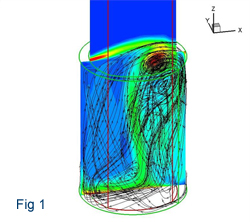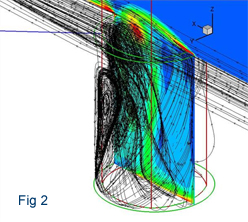Circular cavity flows (aircraft fuel vents)
Marco Grottadaurea and Dr. Aldo Rona
Department of Engineering,
University of Leicester
CFD prediction of the instantaneous vorticity magnitude at the cavity mid-span and out of plane streamlines of the short-time averaged 3D velocity field.
Figure 1: Port view.
Figure 2: Starboard view.


Aircraft pressure relief valves are used to protect the fuel tanks of wide-body civil aircraft from over-pressurization. The relief valve outlet is typically in the shape of a cylindrical hole, or cavity, cut in the underside side of the wing skin. At typical approach speeds of around Mach 0.3, the flow past the cylindrical cavity can become unsteady. This produces an unwanted tonal contribution to the airframe landing noise.
A numerical investigation of this phenomenon was performed in consultation with Airbus France, as part of the EU programme AeroTraNet. A three-dimensional time-dependent CFD model of a Mach 0.3 cavity flow was obtained using the in-house CFD code Cosmic. The cavity length to diameter ratio 0.71 and Reynolds number 0.68 million were selected with Airbus France, to be representative of a wide-body civil aircraft pressure relief outlet.
The Euler numerical model predicts an unsteady self-sustained flow instability in the cavity. The instability is different from the well-documented Rossiter mechanism, which involves essentially two-dimensional longitudinal vorticity and pressure waves. The flow in the cylinder is three-dimensional and asymmetric, suggesting an azimuthal instability. Figures 2, 3 and 4 show the presence of a dominant recirculation in the enclosure, where the main vortex axis is 45 degrees to the free-stream inflow (positive x axis).
References
- Grottadaurea, M., Rona, A.: (50%)
The role of the inflow momentum thickness in subsonic cylindrical cavity noise generation, ICSV14 Paper 165, 14th International Congress on Sound and Vibration, Cairns, Australia, 9-12 July 2007. - Grottadaurea, M., Rona, A.: (50%) Noise sources from a cylindrical cavity, AIAA Paper 2007-3723, 13th CEAS/AIAA Aeroacoustics Conference, Rome, Italy, 21-23 May 2007.